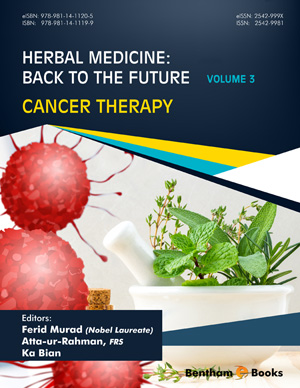Abstract
The use of plant-derived medications in the treatment and prevention of diseases, i.e., phytotherapy, comprises the traditional knowledge of therapeutic advantages deriving from the use of herbal parts to prevent, protect against and cure several pathologic conditions, such as cancerous, metabolic and inflammatory diseases. Herbal medications are prevalent in countries with limited resources, but, recently, increasing attention is devoted to their exploitation in cancer management on the basis of their low cost and side effects absence compared to conventional radiation or chemotherapic cancer approach. Currently, about 114,000 herbal extracts have screened for anticancer activity and 60% of the commercially available and clinically used cancer drugs, such as vinblastine and vincristine, paclitaxel, campothecin and its derivatives, are from natural sources. These compounds are active against a number of cancer types (ovarian, breast, lung, colon, liver, blood, prostate cancer). There are many types of cancer elicited by several factors that still render this disease a major public health problem, almost everywhere in the world.
The human body is constantly exposed to free radicals arising from exogenous and endogenous origins, which cause oxidative stress. Oxidative stress is closely related to various diseases, including cancer. There are many evidences that ROS are pivotal in cancer progression (via damage of DNA leading to genomic instability) and regression (via cell death induction through oxidative stress burst). Antioxidants stabilize free radicals and, in turn, prevent the oxidative stress, playing a key role in protection of the body, In this context, natural plants-derived antioxidants are universally considered very important for the prevention and treatment of oxidative stress and cancer. However, a dual role of plants in ROS generation or scavenging is recognized as plants extracts can also increase ROS production in the cells. Consequently, the role of plant extracts in ROS balancing inside cancer cells is a very fascinating feature in phytotherapy. Among the plants reported in traditional medicine as a very panacea in active compounds, Carica papaya and Azadiracta indica (also known as Neem) extracts from different parts (leaves, seeds, fruits, etc.) are scientifically validated in the treatment of several diseases, including cancer. In this context, the two plants have different impact on cancer cell lines. In particular hydro-alcoolic extract of Neem leaves shows a pro-oxidant activity in hepatoma HepG2 cells, whereas water extract of C. papaya seeds exerts an anti-oxidant activity in leukemia HL-60 cells. Neem extract is unable to quench oxidative stress induced on HepG2 and synergizes with hydrogen peroxide (H2O2) in inducing cell death. Conversely, C. papaya extract quenches ROS induced by H2O2 in HL-60 cells but at the same time negatively affects cell viability. These evidences corroborate the idea that the extracts from plants could act in patients with cancer to modulate oxidative homeostasis and obtain benefit during cancer therapy.Keywords: Azadirachta indica, Carica papaya, HepG2 cells, HL-60 cells, Neem, Reactive Oxygen Species (ROS).






















